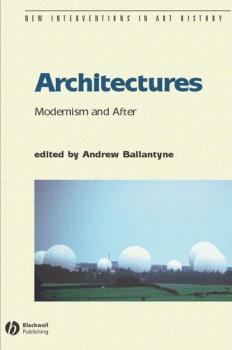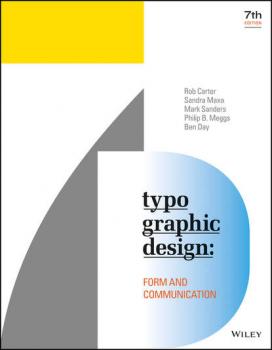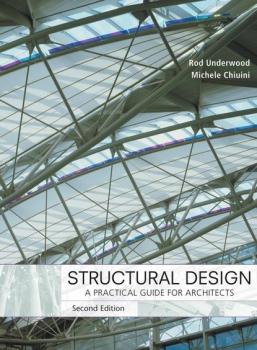ТОП просматриваемых книг сайта:















Архитектура
Различные книги в жанре Архитектура, доступные для чтения и скачиванияАннотация
Architectures: Modernism and After surveys the history of the building from the advent of industrialization to the cultural imperatives of the present moment. Brings together international art and architectural historians to consider a range of topics that have influenced the shape, profile, and aesthetics of the built environment. Presents crucial «moments» in the history of the field when the architecture of the past is made to respond to new and changing cultural circumstances. Provides a view of architectural history as a part of a continuing dialogue between aesthetic criteria and social and cultural imperatives. Part of the New Interventions in Art History Series, which is published in conjunction with the Association of Art Historians.
Аннотация
The bestselling introduction to designing the written word Typographic Design: Form & Communication is the definitive reference for graphic designers, providing a comprehensive introduction to the visual word. Done well, typopgraphy can communicate so much more than the words themselves. Typographic design determines how you feel about a message, the associations you make, and ultimately, the overall success of the communication. Typographic design extends from the page to the screen, and is a critical element of almost any graphic design project. This book provides essential guidance on everything related to type: from letterforms and negative space, to messaging, processes, and history, aspiring designers will find great utility in mastering these critical concepts. This new seventh edition has been fully updated with new coverage of contemporary typography processes, updated case studies, and new examples from branding, print, web, motion, and more. On-screen typographic design concepts are discussed in greater detail, and the online supplemental materials include new flashcards, terminology and quizzes. Understand design factors as they relate to type Explore communication and typographic messaging Learn how typography has evolved, and where it is headed Adopt established approaches to designing with type The irony of typographic design is that, when done well, it often goes unnoticed—but its impact on a project’s overall success is undeniable. Typography can make or break a page, can enhance or overpower an image, and can obscure a message or bring it into sharp focus. It is one of the most powerful tools in the graphic designer’s arsenal, and Typographic Design is the complete, practical introduction.
Аннотация
Written by the chair of the LEED-Neighborhood Development (LEED-ND) initiative, Sustainable Urbanism: Urban Design with Nature is both an urgent call to action and a comprehensive introduction to «sustainable urbanism»–the emerging and growing design reform movement that combines the creation and enhancement of walkable and diverse places with the need to build high-performance infrastructure and buildings. Providing a historic perspective on the standards and regulations that got us to where we are today in terms of urban lifestyle and attempts at reform, Douglas Farr makes a powerful case for sustainable urbanism, showing where we went wrong, and where we need to go. He then explains how to implement sustainable urbanism through leadership and communication in cities, communities, and neighborhoods. Essays written by Farr and others delve into such issues as: Increasing sustainability through density. Integrating transportation and land use. Creating sustainable neighborhoods, including housing, car-free areas, locally-owned stores, walkable neighborhoods, and universal accessibility. The health and environmental benefits of linking humans to nature, including walk-to open spaces, neighborhood stormwater systems and waste treatment, and food production. High performance buildings and district energy systems. Enriching the argument are in-depth case studies in sustainable urbanism, from BedZED in London, England and Newington in Sydney, Australia, to New Railroad Square in Santa Rosa, California and Dongtan, Shanghai, China. An epilogue looks to the future of sustainable urbanism over the next 200 years. At once solidly researched and passionately argued, Sustainable Urbanism is the ideal guidebook for urban designers, planners, and architects who are eager to make a positive impact on our–and our descendants'–buildings, cities, and lives.
Аннотация
Civic Revolutionaries offers a practical guide for renewing the great American tradition of spirited, breakthrough community leadership. By their very nature, revolutionary leaders help their communities reconcile the competing values on which our nation was built: individualism and community, freedom and responsibility, trust and accountability, economy and society. Like the Founders, today's civic revolutionaries are extraordinary leaders who are deeply committed to place, not just to specific issues or constituencies. They provide the vital spark, inspiring others who must ultimately own the revolution if it is to be successful. Written for leaders in business, government, education, and community, Civic Revolutionaries features practical guidance and in-depth case studies from communities across the country. The book provides tested advice to both new and seasoned leaders and draws essential lessons from the American revolutionary tradition to demonstrate how to become an effective leader within the community. Read a Charity Channel review: http://charitychannel.com/publish/templates/?a=294&z=25
Аннотация
When nature inspires our architecture-not just how it looks but how buildings and communities actually function-we will have made great strides as a society. Biophilic Design provides us with tremendous insight into the 'why,' then builds us a road map for what is sure to be the next great design journey of our times. -Rick Fedrizzi, President, CEO and Founding Chairman, U.S. Green Building Council «Having seen firsthand in my company the power of biomimicry to stimulate a wellspring of profitable innovation, I can say unequivocably that biophilic design is the real deal. Kellert, Heerwagen, and Mador have compiled the wisdom of world-renowned experts to produce this exquisite book; it is must reading for scientists, philosophers, engineers, architects and designers, and-most especially-businesspeople. Anyone looking for the key to a new type of prosperity that respects the earth should start here.» -Ray C. Anderson, founder and Chair, Interface, Inc. The groundbreaking guide to the emerging practice of biophilic design This book offers a paradigm shift in how we design and build our buildings and our communities, one that recognizes that the positive experience of natural systems and processes in our buildings and constructed landscapes is critical to human health, performance, and well-being. Biophilic design is about humanity's place in nature and the natural world's place in human society, where mutuality, respect, and enriching relationships can and should exist at all levels and should emerge as the norm rather than the exception. Written for architects, landscape architects, planners,developers, environmental designers, as well as building owners, Biophilic Design: The Theory, Science, and Practice of Bringing Buildings to Life is a guide to the theory, science, and practice of biophilic design. Twenty-three original and timely essays by world-renowned scientists, designers, and practitioners, including Edward O. Wilson, Howard Frumkin, David Orr, Grant Hildebrand, Stephen Kieran, Tim Beatley, Jonathan Rose, Janine Benyus, Roger Ulrich, Bert Gregory, Robert Berkebile, William Browning, and Vivian Loftness, among others, address: * The basic concepts of biophilia, its expression in the built environment, and how biophilic design connects to human biology, evolution, and development. * The science and benefits of biophilic design on human health, childhood development, healthcare, and more. * The practice of biophilic design-how to implement biophilic design strategies to create buildings that connect people with nature and provide comfortable and productive places for people, in which they can live, work, and study. Biophilic design at any scale-from buildings to cities-begins with a few simple questions: How does the built environment affect the natural environment? How will nature affect human experience and aspiration? Most of all, how can we achieve sustained and reciprocal benefits between the two? This prescient, groundbreaking book provides the answers.
Аннотация
Shanghai's illustrious history and phenomenal future is celebrated in this book, which examines the evolution of the city's architecture and urban form in order to contextualise the challenges facing the city today. The physical legacies that reflect Shanghai's uniqueness historically and contemporarily are examined chronologically using specific case studies of exemplary architecture interwoven in a compelling narrative that unlocks the many mysteries surrounding this amazing metropolis. Some of the most influential colonial architecture in the world, outstanding examples of Modernism and Art Deco, and an exceptional selection of eclectic and vernacular architecture reflecting Shanghai's many adopted cultures are revealed. This is the first book ever to examine this remarkable subject in a manner that is both comprehensive and captivating in its written content and stunningly illustrated with over 300 archive and contemporary photographs and maps.
Аннотация
From the moment it was first published, Facility Management became the ultimate reference for facility and design professionals who want to create a productive workplace that corresponds to the short- and long-term goals of their corporation. This Second Edition provides complete, fully up-to-date information and guidance on the evolving facility management profession that will help facility professionals and their service providers meet and exceed these goals.
Аннотация
Written for the practicing architect, Structural Design addresses the process on both a conceptual and a mathematical level. Most importantly, it helps architects work with structural consultants and understand all the necessary considerations when designing structural systems. Using a minimum of simple math, this book shows you how to make correct design calculations for structures made from steel, wood, concrete, and masonry. What?s more, this edition has been completely updated to reflect the latest design methods and codes, including LRFD for steel design. The book was also re-designed for easy navigation. Essential principles, as well as structural solutions, are visually reinforced with hundreds of drawings, photographs, and other illustrations–making this book truly architect-friendly.
Аннотация
Industrial Design: Materials and Manufacturing Guide, Second Edition provides the detailed coverage of materials and manufacturing processes that industrial designers need without the in-depth and overly technical discussions commonly directed toward engineers. Author Jim Lesko gives you the practical knowledge you need to develop a real-world understanding of materials and processes and make informed choices for industrial design projects. In this book, you will find everything from basic terminology to valuable insights on why certain shapes work best for particular applications. You'll learn how to extract the best performance from all of the most commonly used methods and materials.
Аннотация
The new student edition of the definitive architectural reference For seventy-five years, Architectural Graphic Standards has been the go-to reference for architects, builders, and engineers. Revised for the first time since 2000, Architectural Graphic Standards, Student Edition gives students their own handy resource. Carefully abridged from the Eleventh Edition of Architectural Graphic Standards, this Student Edition features the same richly detailed graphics and text that have made Architectural Graphic Standards a classic, but updated and reorganized in a way that is relevant to today's student. Thousands of illustrations and a rich index offer immediate access to hundreds of architectural elements, while the wide variety of topics covered makes this work relevant throughout a student's architecture education and into the early stages of professional practice. With a wealth of information for the student preparing for professional practice, this new edition: * Covers building standards and practices, materials and systems, and details for every type of project * Follows CSI's Uniformat, a classification system that closely matches an architect's workflow * Features completely updated content with a wide variety of standard architectural details * Offers an ancillary Web site featuring sample curriculums, student exercises, classroom projects, PowerPoint(r) slides, and more










